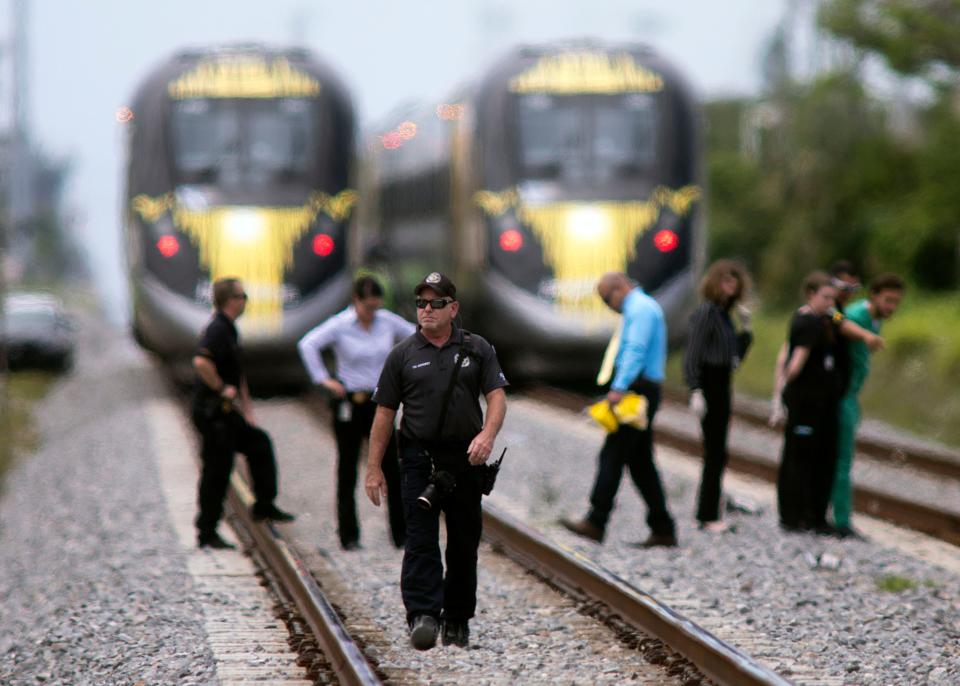In trying to stop crashes at Brightline crossings, train horns get silence treatment | Frank Cerabino
There’s more talk about adding safety measures at Brightline railroad crossings in South Florida.
The higher-speed rail service and the Florida Department of Transportation announced a $45 million program, which would be partially paid through federal grants, to make railroad crossings safer.
These safety measures include flexible poles designed to keep cars from driving around the closed gates, fencing and landscaping near the intersections, and something called “rail dynamic envelopes” – pavement markings designed to keep cars and pedestrians from getting caught between the closing gates.
But there’s one safety measure that’s not on the table: requiring the approaching speeding trains to sound their horns.

Ominous signs: The 'banning' of school library books in Florida a symptom of life in 'DeSantistan' | Frank Cerabino
Echoes of '1984': Handling the applications for Gov. DeSantis' elections police force | Frank Cerabino
Why isn't this called 'grooming'? DeSantis using Black kids as Critical Race Theory props is political child abuse | Frank Cerabino
That’s because whatever benefits are had by trains blowing their horns has been deemed too politically untenable for local officials to sanction.
People who live near train crossings have effectively persuaded lawmakers at the state and local levels that passing trains shouldn’t be allowed to sound a warning blast that disturbs their peace.
And that instead of achieving a measure of safety through an audible warning to vehicle and pedestrian traffic, train intersections could be made safe through some “quiet zone” improvements, such as four-way gates and signs.
Beware of silent but deadly trains
This attack on train horns in Florida goes back to 1984, when state legislators allowed cities to ban horns on the Florida East Coast Railway tracks at 511 of the 600 crossings between Miami and Jacksonville between the hours of 10 p.m. and 6 a.m.
The results were dramatic.
Seven years later, the Federal Railroad Administration stepped in and got the state to rescind the law, noting a 195 percent increase in nighttime train-crossing crashes in quiet-zone intersections.
More: Brightline train, FDOT roll out a $45 million plan to eliminate train-crossing deaths
When, where and how: A detailed list of Brightline train deaths in Palm Beach County
But the people who lived near the heavily populated route of the FEC tracks continued to push to silence the train horns, and not only at night.
In 1994, Congress tasked the Federal Railroad Administration to come up with a standard for the 250 communities around the nation that had sought train-whistle bans.
That standard was still under discussion six years later when John V. Wells, the deputy administrator of the Federal Railroad Administration, testified before Congress.
Wells testified that after the FRA made South Florida trains sound their horns at night, the crash rate went back down to levels that existed before the whistle ban.
And that national studies of collisions at train intersections showed a 66% increase in risk of crashes at silent intersections with flashing lights and gates.
The horn is helpful in identifying the position of the train in relation to the crossing as well as its rate of approach, Wells testified.
“The train horn simplifies this process in many cases by providing an auditory clue that the train is present and also the direction from which it may be approaching,” he testified. “The horn’s role may be particularly crucial at crossing with limited sight distance.”
Peace and quiet prevails over safety
But when the FRA issued its decision in 2003, it allowed communities to establish quiet-zone railroad intersections if they erected four-quadrant gates that block the extend across the entire roadway in a way that prevents drivers from zig-zagging around the closed gates.
The cost of these gates was estimated at about $300,000 per intersection, a high price for some communities to pay.
The new rules also lowered the noise levels of the train horn to 110 decibels and required that the horn be blown 15 seconds before arriving at the intersection, not a quarter-mile away, which had been the old rule.
To meet the federal requirements, train intersections across South Florida were improved with lighting, signage, new crossing gate arms and medians and curbs designed to frustrate impatient drivers.
It took a few years, but eventually it created one big train-crossing quiet zone between Miami and West Palm Beach.
Jim Kovalsky, the president of the Florida East Coast Railway Society, warned at the time that the silent passage of trains would be both historic and more dangerous, especially to people who walk along the tracks or fish from railroad bridges.
“Those people until now have had a warning they didn’t realize,” Kovalsky said in 2108. “Those people have lost their warning.”
The nearly 60 casualties on the Brightline tracks has helped make Florida second in the nation for casualties per track mile. And the company has made some novel attempts at keeping drivers and people off the tracks.
This included hiring people as “safety ambassadors” to stand near the railroad intersections and do their best to keep pedestrians, cyclists and motorists from trying to cross the tracks once the gates go down.
And now, there’s this new batch of railroad crossing safety measures. Flexible pole delineators. Rail dynamic envelopes. Channelized fencing.
The train service estimates that these new safety enhancements will save 95 lives and 146 crashes during the next 20 years.
I hope it works.
If not, what about blowing the horn?
fcerabino@gannett.com
@FranklyFlorida
This article originally appeared on Palm Beach Post: Blowing train horns safety measure not used at South Florida crossings

